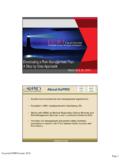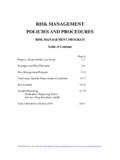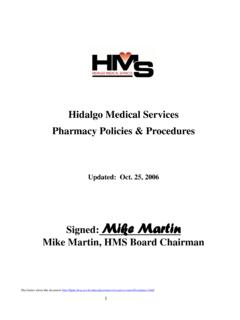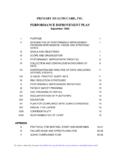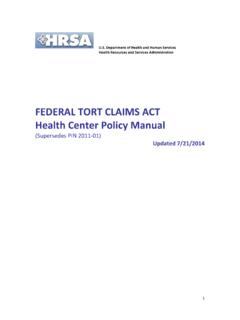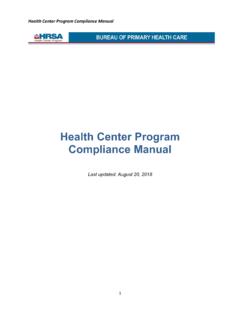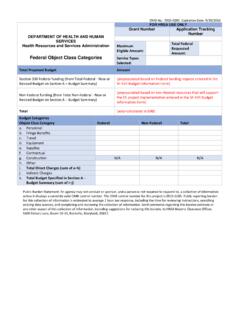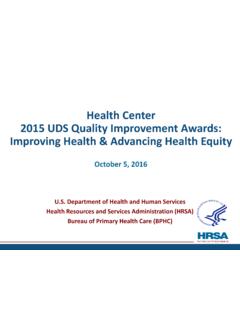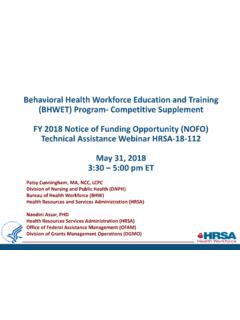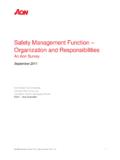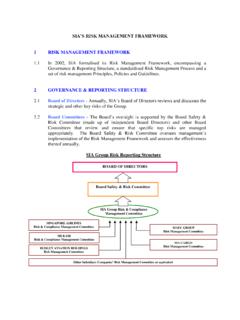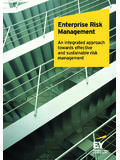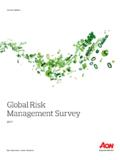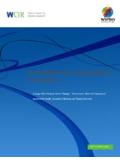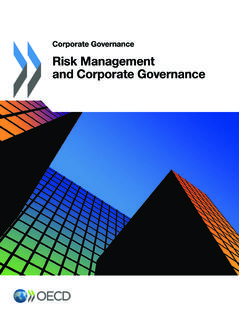Transcription of RISK MANAGEMENT POLICIES AND PROCEDURES
1 RISK MANAGEMENT . POLICIES AND PROCEDURES . RISK MANAGEMENT PROGRAM. Table of Contents Page(s). Purpose, Responsibility and Scope 1-2. Strategies and Plan Elements 3-8. Risk MANAGEMENT Program 9-13. Continuous Quality Improvement Committee 14-17. Risk Control 18-20. Incident Reporting 21-33. Medication Dispensing Errors Adverse Drug Reactions (ADR). Early Intervention Services/HIV 34-47. Disclaimer about this document Risk MANAGEMENT Program PURPOSE. Risk MANAGEMENT is a systematic process of identifying, evaluating and reducing losses associated with patient, employee or visitor injuries, property loss or damages and other sources of potential legal liability. RESPONSIBILITY. The Board of Directors is entrusted with the responsibility for the oversight of the Risk MANAGEMENT Program at _____ and its satellite facilities.
2 This responsibility is delegated to the Chief Executive Officer and the _____ staff. SCOPE. The Risk MANAGEMENT Program encompasses review of the areas of actual or potential sources of risk and/or liability involving patients, visitors, staff and property. This incident reporting system is utilized to collect and trend undesirable or adverse occurrences in all areas throughout the facilities. The Quality Improvement Committee may assist with the data collection in the Risk MANAGEMENT areas through Medical Staff and Clinical Staff monitoring and evaluating specific data information. To accomplish this function, the Risk Manager or the CEO's designee is responsible for developing and maintaining a Risk MANAGEMENT Program that meets the basic operational needs of _____. Among the programs required to meet that end is an insurance program for both commercial and medical malpractice coverage and the development of new programs designed to train staff in minimizing or eliminating risks or safety concerns on a corporate-wide basis.
3 The Risk Manager or the CEO appoints a designee to handle this function and make regular reports to the CEO or his/her designee on a monthly basis, or more frequently, if necessary. The Risk Manager will review risk exposure on a regular basis and make specific recommendations to the CEO when changes in the Risk MANAGEMENT Program are needed. An example of this would be the increase of coverage for buildings and automobiles, malpractice and general liability POLICIES or the need for new safety or staff training programs in specific areas. The following is an outline of insurance needs and training programs that would address areas of risk exposure. While the list is not all inclusive, it will assist in the development of a successful Risk MANAGEMENT Program: COMMERCIAL INSURANCE. 1. Property &Casualty 2. Auto 3. Business Interruption Disclaimer about this document 4.
4 General Liability 5. Directors and Officers Coverage 6. Errors and Omissions 7. Inland Marine ( , accounts receivable, valuable papers, electronic data processing). 8. Crime ( , employee dishonesty, Welfare and Pension Plan, ERISA Compliance). 9. Worker's Compensation 10. Benefits ( , health insurance, disability, group life, employment practices). TRAINING PROGRAMS. 1. Safety Programs (Safety Committee: fire drills, disaster planning, workforce safety, building safety inspections, workplace violence). 2. OSHA Training Compliance (exposure to blood borne pathogens, needle sticks, hazardous waste disposal, employee injuries, ergonomic design). 3. Security Programs (employee patient safety issues). 4. Confidentiality Programs (patient and staff confidential information). 5. Provider-Patient Care Issues ( , patient complaints of improper medical treatment or dealing with difficult patients.)
5 RISK MANAGEMENT STRATEGIES. In order to approach the process of Risk MANAGEMENT systematically, _____ utilizes the following four-step model for Risk MANAGEMENT : The identification of risks The analysis of the risk identified The treatment of risks The evaluation of risk treatment strategies This model assists in setting priorities for Risk MANAGEMENT activities and ensures a comprehensive Risk MANAGEMENT effort. Risk Identification: Risk Identification is the process through which the Clinic Staff becomes aware of risks in the health care environment that constitute potential loss exposures for the _____. The staff will utilize the following information services to identify potential risks : Identification of trends through the incident reporting system Patient, visitor, staff and physician complaint reports Performance improvement functions Peer review activities Informal discussions with MANAGEMENT and staff members Risk Analysis: Disclaimer about this document Risk Analysis is the process of determining the potential severity of the loss associated with an identified risk and the probability that such a loss will occur.
6 These factors establish the seriousness of a risk and will guide MANAGEMENT in the selection of an appropriate risk treatment strategy. Risk Treatment: Risk Treatment refers to the range of choices available to MANAGEMENT in handling a given risk. Risk Treatment strategies include the following: A. Risk acceptance involves assuming the potential loss associated with a given risk and making plans to cover any financial consequence of such losses. B. Risk avoidance is a strategy utilized when a given risk poses a particularly serious threat that cannot be effectively reduced, and the conduct or service giving rise to the risk may perhaps be avoided. C. Risk reduction or minimization involves various loss control strategies aimed at limiting the potential consequences or frequency of a given risk without totally accepting or avoiding the risk.
7 Strategies may include staff education, policy and procedure revision and other interventions aimed at controlling adverse occurrences without completely eliminating risk activities. Any single strategy or combination of the above Risk MANAGEMENT strategies may be employed to best manage a given situation. Risk MANAGEMENT Evaluation The final step in the Risk MANAGEMENT process is risk MANAGEMENT evaluation, whereby the effectiveness of the techniques employed to identify, analyze and treat risks are assessed and further action taken when warranted. If improvement and/or resolution of the risk is evident, additional follow-up will be done at predetermined intervals to evaluate continued improvement. RISK MANAGEMENT PLAN ELEMENTS. The _____ Risk MANAGEMENT Program is concerned with a variety of issues and situations that hold the potential for liability or losses for the clinic.
8 It addresses the following categories of risk: Patient-Related risks Confidentiality and appropriate release of patient medical information The securing of appropriate informed patient consent for medical treatment Nondiscriminatory treatment of patients, regardless of race, religion, national origin or payment status Protections of patient valuables from loss or damage Disclaimer about this document Medical Staff-Related risks Medical Staff peer review and quality/performance improvement activities Confidentiality and protection of the data obtained Medical Staff credentialing, appointment and privileging processes Employee - Related risks Maintaining a safe work environment Reduction of the risk of occupational illnesses and injury Provision for the treatment and compensation of workers who suffer on-the-job injuries and work-related illnesses Ensuring nondiscrimination in recruitment, hiring and promotion of employees Other risks Ensuring mechanisms to prevent and reduce the risk of losses associated with fire, flood.
9 Severe weather and utilities malfunction Ensuring the development and implementation of emergency preparedness plans Ensuring that appropriate protocols are in place for hazardous materials/waste MANAGEMENT Maintaining a safe environment for patients and visitors Assisting Quality/Performances Improvement efforts to identify those areas which represent an opportunity to improve patient care and reduce risk ANNUAL APPRAISAL. As part of the Risk MANAGEMENT Program, the scope, organization and effectiveness of Risk MANAGEMENT activities will be reviewed annually. Program revisions will be recommended, approved and implemented as necessary. Disclaimer about this document CORPORATE RISK MANAGEMENT PROGRAM. I. AUTHORITY. 1. The Board of Directors and CEO of _____ strive to provide a safe environment for customers, visitors and employees by requiring and supporting the establishment of an effective Risk MANAGEMENT Program.
10 II. DUTIES AND RESPONSIBILITIES. 1. A Risk Manager appointed by the Chief Executive Officer and qualified by experience and/or education shall be responsible for the development, implementation and monitoring of a Corporate Risk MANAGEMENT Program including the creation and maintenance of any committees deemed necessary. 2. The Risk Manager shall be responsible for coordinating the investigation of significant incidents including, but not limited to, review of the medical record, interviews of any knowledgeable personnel, review of pertinent POLICIES and/or PROCEDURES , and referral of the occurrence as necessary to the appropriate department head or committee(s). 3. The Corporate Risk MANAGEMENT Program shall be based on the monitoring and evaluation of the following: a. customer care occurrences and other center events b.
